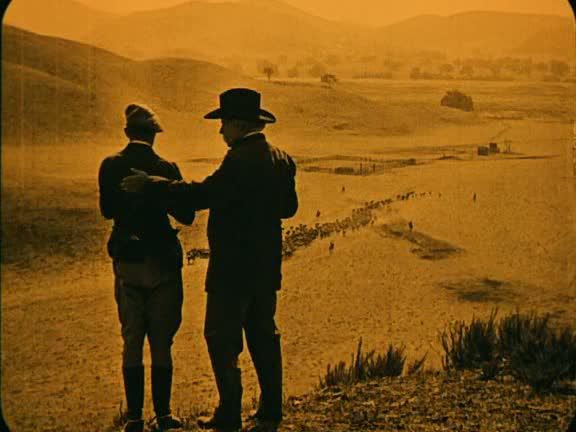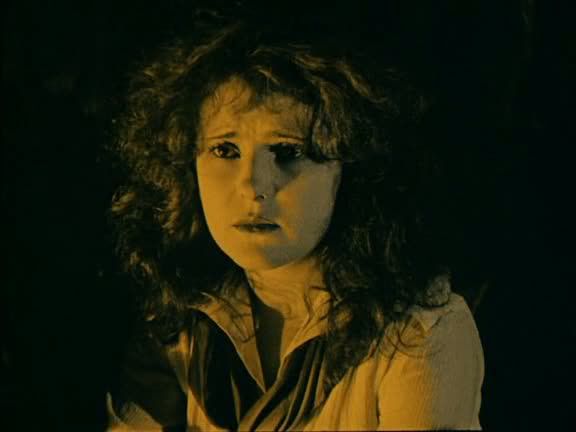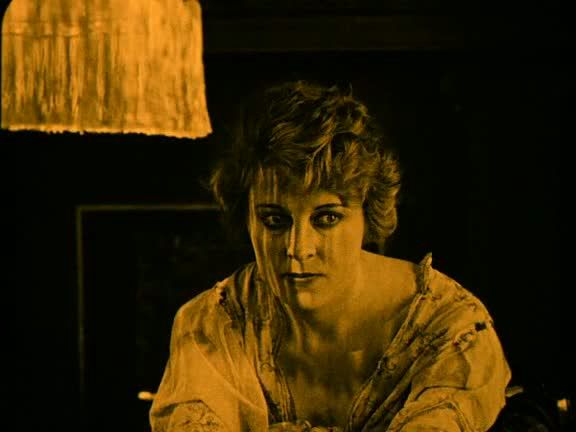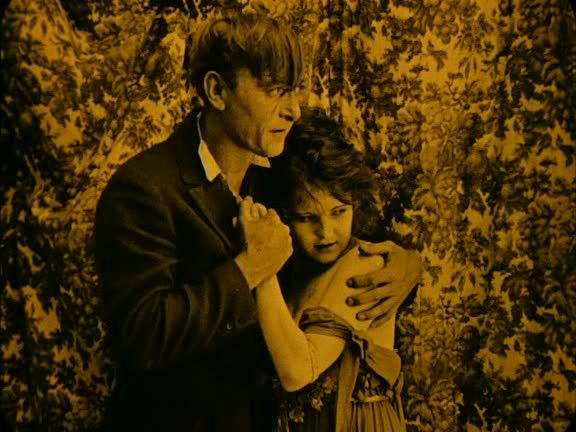

Bucking Broadway is a very early Western from John Ford, one of his earliest surviving works; it was once lost before being rediscovered in France in 2002. It's an hour-long Western melodrama about the ranch-hand Cheyenne Harry (Harry Carey), whose romance with the farm owner's daughter Helen (Molly Malone) is interrupted when the wealthy urban businessman Thornton (Vester Pegg) steals her away and takes her to New York. Harry, heartbroken, follows her to the city in order to get her back. It's a potent examination of the opposition between the folksy, noble West and the decadent, sleazy urbanity of the East.
The story is very simple, almost iconic in its application of broad archetypes, but Ford's presentation of this elemental tale is extraordinarily poetic and sensuous. It's a gorgeously shot, moody and melancholy Western; one title card, appearing as Harry moons around the ranch in Helen's absence, economically read, "Loneliness, dreams and memories." Ford uses a lot of closeups here, probing the intense emotions of this story through the actors' faces. The closeups have a raw, shadowy beauty that sears away any trace of melodrama in this story, leaving behind only the very real underlying emotions. When Harry proposes to Helen, in the cabin that he's built for them to live in, the flickering candlelight sculpts her face, alternately serious and delighted, into a sweetly pretty icon of youth and innocence, moved by Harry's proposal and only a little worried about what her stern father (L.M. Wells) will think. This scene, so sweet and sensual, makes it a little puzzling why Helen would then so quickly be swayed away from Harry by the smooth-talking man from the city. The portion of the film dealing with his seduction of her seems more than a little clipped and rushed, and Helen's change of heart is unconvincing, beyond a rather offensive insinuation that all women are weak-willed and susceptible to flashy manners.
Indeed, the closeups of Helen on her trip to New York suggest that she's already realized what a mistake she's made, as Ford captures the haunted expression in her eyes, glaring up at the camera. In one affecting scene, Ford juxtaposes Helen's face, half-shaded with deep black shadow, against an image of a woman (Gertrude Astor) who a title says that Thornton "introduces as" his sister (which of course suggests that she's anything but). Ford shoots this other woman in a way that, oddly enough, seems to anticipate film noir all the way back in 1917: she's sitting by a lampshade, which casts a gauzy, striped shadow across her face as she looks at the new girl. The suggestion is that this is an old lover of Thornton's, used up and imprisoned by her decadent lifestyle, a hint of the future for Helen should she stay with this no-good man.


Ford is making the city a place of corruption and sexual iniquity, all dark interiors in contrast to the hilly fields of Wyoming from the first half of the film, with animals spread out across the plains and cowboys making photogenic silhouettes in the foreground, smoking and squinting out at the horizon from horseback. When Harry arrives in the city, Ford makes much of the fish-out-of-water comedy of the cowboy in the city: he mistakes a steaming water heater, which he's obviously never seen before, for a rattlesnake, and pulls a revolver, frightening the bellboy as he searches for the snake. Later, continuing the parallels between West and East, he finds "a seasoned guide" to the city in a prostitute and her pimp, who attempt to rob him before the city woman is moved by his down-home tale of love and loss.
Ford's feel for comic relief, always a prominent characteristic of his work, is also apparent in the earlier part of the film, when Harry tries to win Helen back from Thornton by buying some fancy clothes, so he can dress like the city slicker. Harry gets behind the counter at the store to try on his new pants, glancing anxiously out towards the front of the store hoping that no one will come in — although the way Ford cleverly stages the shot, it looks as though Harry is glancing at the camera, breaking the fourth wall, as though wondering if the audience will see him undressing like this. (Ford unfortunately follows this scene with a wince-inducing racist gag, when Harry sees a black man wearing the same outfit as him and grows angry with the store owner.)
The film climaxes when Harry and his cowboy pals get into a frenetic brawl with Thornton and his friends at a hotel, after the sequence that gave the film its name, a few blue-tinted shots of the cowboys roaring through the center of New York on horseback, weaving through traffic and waving their hats in the air, Wyoming having truly come to the big city. The brawl itself is frenzied and fast-paced, utterly chaotic, a flurry of half-comic action to cap off the film's conflict between East and West.
This was an early, budget Western for Ford, from a period in his career when he was cranking out economical little Westerns like this in a few days of shooting. With that in mind, it's surprising that the resulting film, despite its clichéd story, is anything but inconsequential. Bucking Broadway is an emotionally compelling, beautifully shot film that proves the director was already a supreme visual talent even this early in his career.

9 comments:
Thanks for bringing such light on a little gem by John Ford! It is interesting to discover how Ford had so much talent in his own unique way.
Thanks, Michaël. This film's an extra on the Criterion-released Stagecoach, and it's well worth tracking down to see how great Ford was even very early in his career.
"The story is very simple, almost iconic in its application of broad archetypes, but Ford's presentation of this elemental tale is extraordinarily poetic and sensuous."
The discovery of this film in 2002 was of course cause for celebration. The lion's share of early Ford silents sadly remain MIA, but there's hope a few more may yet surface. You have greatly enhanced, in fact established the literature on this particular film (highly praised by Rosenbaum, who considers it nearly as good as STRAIGHT SHOOTING, released the same year) which has not received this kind of exquisite writing and assessment anywhere from anyone to this point. Despite the fact that I've owned the Criterion STAGECOACH for quite some time, I have not watched this addition, sorry to say. But I will, and soon. Your discussion of the compelling use of close-ups, the film's exceeding poetry and strain of emotionalism makes for a most persuasive recommendation, but beyond that I was fascinated by the way you attest that Ford contasted the urban and rural milieus, and that the trademark comic relief is alive and well in this very early work.
Another essay to stand with your finest work.
Thanks, Sam. I'll be curious to hear what you think when you do watch it. I've been catching up with some Ford silents lately and loving them all, his talent was pretty firmly in place even early on. I'd say this one is even better than Straight Shooting, which is also quite good but doesn't have the same moody beauty.
Ed, I'm going to try to track down a copy of this in the next day or two and get back here--I wouldn't make the argument, but I think there's a case for Ford doing his best work in the silent medium. There's a simplicity to his films, particularly in the twenties, that is really stirring, and I find that often the talkies of his that I admire most are those that are the most direct and simple and like his silents.
Looking forward to your thoughts, Peter. You've seen way more Ford than I have so I'm curious how you'd place this one in the context of his career. I'm not yet comfortable enough with Ford as a whole to make that silent vs. sound argument, but I'd agree that his silent period is very, very strong.
I really need to watch this again - my only viewing came late at night on the tail end of plunging through that Criterion disc - but I remember having a complete blast with it. Straight Shooting from the same year is of course the better known of the two, and probably the stronger movie, displaying as it does more of the emotional tendencies we think of with Ford today, but they're both great and certainly go a long way towards showing, as has been said, that Ford's sublime pictorial sense was there from the beginning.
I've seen I guess a reasonable amount of Ford's silent work by now, and while I'm not sure I'd go so far as to claim it superior to his sound stuff, it was an undeniably rich period for him, and when he was on point his films from that era deserve to be mentioned right alongside the other high masterpieces of the form.
Drew, I'd say this is every bit as emotional as Straight Shooting, even though it also has some more of that Fordian folksy humor as well. But yeah, both of them are fantastic early Westerns.
As I remember it, Straight Shooting was more representative of the reflective qualities that would become more and more common in Ford's work, whereas this was more slanted towards light farce, but maybe I'm wrong, like I said I could definitely stand to see it again.
Post a Comment